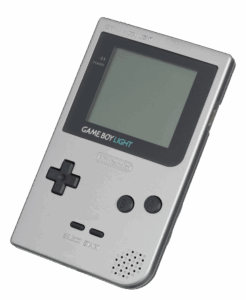
The Nintendo Game Boy Light was a version of the Game Boy released exclusively in Japan in April 1998, just a few months before the Game Boy Color. It was the first Game Boy to feature a built-in backlit screen, a major feature at the time that eliminated the need for third-party accessories to play in low-light conditions.
Key features
- Built-in backlight: The main feature of the Game Boy Light was its electroluminescent (EL) backlit screen. This provided a soft, blue-green glow that made the monochrome display visible in the dark.
- Improved battery life: While the Game Boy Pocket used two AAA batteries, the Light version reverted to using two AA batteries, resulting in a significantly longer battery life. With the backlight on, it could last for about 12 hours, and up to 20 hours with the light off.
- Power switch: A three-way power switch allowed users to turn the system on with the backlight off or with the backlight on.
- Form factor: It retained a similar compact design to the Game Boy Pocket but was slightly taller and heavier to accommodate the larger batteries.
- Exclusive to Japan: The Game Boy Light was never officially released outside of Japan, making it a rare and sought-after collector’s item for fans worldwide.
Release and limited editions
The console was initially available in gold and silver. Several special and highly limited editions were later released, which are now exceptionally rare:
- Toys “R” Us translucent yellow
- Tezuka Osamu World Shop translucent red
- Astro Boy and Famitsu transparent editions
- A rare Pikachu-themed version available for a very limited time at the Pokémon Center in Tokyo
Legacy
- Short lifespan: The Game Boy Light had a very short shelf life, as it was succeeded by the full-color Game Boy Color in October 1998.
- Collector’s item: Due to its limited production and Japan-exclusive release, the Game Boy Light is a prized console among collectors. Its introduction of a built-in light was a significant improvement for the Game Boy line, foreshadowing the backlit screens that would become standard on future Nintendo handhelds like the Game Boy Advance SP.